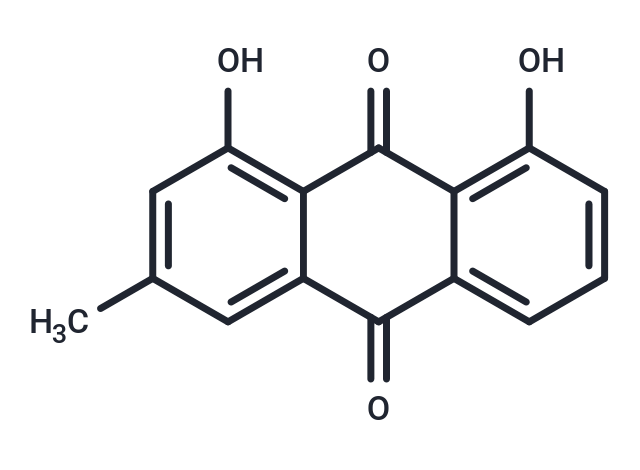Shopping Cart
Remove All Your shopping cart is currently empty
Your shopping cart is currently empty
Chrysophanol (Turkey Rhubarb) is an EGFR/mTOR pathway inhibitor, which can be found in rhubarb, and sorrel.

| Pack Size | Price | USA Warehouse | Global Warehouse | Quantity |
|---|---|---|---|---|
| 50 mg | $32 | In Stock | In Stock | |
| 100 mg | $48 | In Stock | In Stock |
| Description | Chrysophanol (Turkey Rhubarb) is an EGFR/mTOR pathway inhibitor, which can be found in rhubarb, and sorrel. |
| In vivo | Chrysophanol (CA) has been shown to counteract obesity in C57BL/6 mice induced by a high-fat diet (HFD). Through in vivo studies involving male C57BL/6J mice, it was discovered that Chrysophanol significantly mitigates weight gain associated with HFD consumption. Specifically, mice subsisting on an HFD without Chrysophanol treatment experienced a weight increase of 23.92 ± 1.74 g over 16 weeks. In contrast, mice treated with Chrysophanol exhibited a markedly lower weight gain of 16.72 ± 2 g in the same period, underscoring Chrysophanol's potential as an effective intervention against HFD-induced obesity. |
| Cell Research | Chrysophanol (Chrysophanic Acid) is dissolved in DMSO and stored, and then diluted with appropriate medium before use[1]. The cells are seeded at 5×103 cells/mL in 96-well microplates and allowed to attach for 24 h. Chrysophanol (20, 50, 80 and 120 μM) is added to the medium at various concentrations up to 120 μM and for different durations. After treatment, cell cytotoxicity and/or proliferation is assessed by a Cell Counting Kit-8 (CCK-8). Briefly, highly water-soluble tetrazolium salt, WST-8, produces an orange colored water-soluble product, formazan. The amount of formazan dye generated by dehydrogenases in cells is directly proportional to the number of living cells.CCK-8 (10 μL) is added to each well and incubated for 3 h at 37°C, then cell proliferation and cytotoxicity are assessed by measuring the absorbance at 450 nm using a microplate reader.Three replicated wells are used for each experimental condition[1]. |
| Synonyms | Turkey Rhubarb, Chrysophanic Acid, 3-Methylchrysazin |
| Molecular Weight | 254.24 |
| Formula | C15H10O4 |
| Cas No. | 481-74-3 |
| Smiles | Cc1cc(O)c2C(=O)c3c(O)cccc3C(=O)c2c1 |
| Relative Density. | 1.2693 g/cm3 (Estimated) |
| Storage | Powder: -20°C for 3 years | In solvent: -80°C for 1 year | Shipping with blue ice/Shipping at ambient temperature. | |||||||||||||||
| Solubility Information | H2O: < 1 mg/mL (insoluble or slightly soluble) Ethanol: < 1 mg/mL (insoluble or slightly soluble) DMSO: 1.64 mg/mL (6.45 mM), Sonication is recommended. | |||||||||||||||
Solution Preparation Table | ||||||||||||||||
DMSO
| ||||||||||||||||
| Size | Quantity | Unit Price | Amount | Operation |
|---|

Copyright © 2015-2025 TargetMol Chemicals Inc. All Rights Reserved.